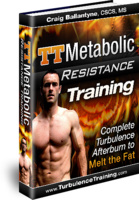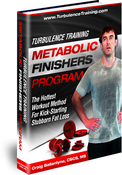Heart Rate Training for Fat Loss
 Hey folks, we’re back today with Alwyn Cosgrove of Results Fitness to share with you more about the biometric testing and heart rate training for fat loss that we talked about in part 2.
Hey folks, we’re back today with Alwyn Cosgrove of Results Fitness to share with you more about the biometric testing and heart rate training for fat loss that we talked about in part 2.
If you would you can Click here to listen to the call.
*******************
Craig: What kind of three exercises do you often see in those mini individual workouts that people are doing?
Alwyn: We have a lot of TRXs at our place, so the exercise may be a total body, like a swing or something like that, and then maybe a lower body exercise such as squat, and an upper body exercise such as push up or a roll. And, within that family tree, so you could do a jump squat, which is an advanced one. A body weight squat would be the intermediate version. A supported or assisted squat with a TRX would be the regressed version. Your exercise would fit into the continuum.
The kettlebell swing could be a hand to hand asymmetrical swing, a two-handed swing, or we could just do a kettlebell deadlift. The push up variation could be an incline flat or decline. The idea with metabolic training is just exercise as much muscle and as much movement as you can, but keep them simple.
Anytime when someone can start to break down their technique, you’re just going to run into an injury because they’re going to push anyway. They’re going to push to get through the set.
Craig: We have these people coming in and they’re doing these three exercises. How many minutes are they going for there?
Alwyn: I would probably run that section for ten minutes. We would maybe do three exercises in three separate parts. They will all come in and we’ll warm up as a group and do some exercises as a group. Then we split into stations. It may be ten minutes at each station. If you do a big circuit of ten exercises, it might take you ten minutes to go around it, and you do three times around. With this, I might just keep you with those three exercises.
Someone else may be doing another exercise with the ropes or the TRX rep trainer. We can set it up in different stations. I would probably do that for ten, but you could do those three exercises for 30 straight minutes. Remember you’re going to rest on a variable work to rest, so I don’t know how many sets you might get. As you tire, you’ll be resting longer.
You’ll hit your heart rate faster and you’ll rest longer. Conceivably in 30 minutes, you might get a set done every minute. You might get 15 sets; one every other minute. It might be as low as eight sets. It doesn’t matter because metabolically we’re getting the work done.
Craig: What heart rate are you having people come back to?
Alwyn: We’re going under 70%. It’s not a complete recovery. Over 85% we call it “Red Zone.” “Yellow Zone” is 70% to 85%, and “Green Zone” means go, is under 70%. The cool thing with the software is that we just program that automatically, and it changes color. It will say your name, it will flash up the number or the percentage and will have a red, yellow, or green background. You can see the color and respond.
Craig: You’re going to do 30 total minutes whether someone did three exercises for 30 minutes, or whether they did one station of three exercises for ten, then on to another station, and do three exercises for ten, then on to another station.
Alwyn: Technically, we could do one single exercise. You could do the whole thing on a bike the same way. We like to use the non-traditional metabolic stuff just to avoid that repetition and that impact. Technically, you could do one exercise. The body will tell you how many sets you’re going to do.
The old school method is that we do 30/60 and we do more sets next week until you get to an upper level number of sets. Then we either increase the length of the work period, or reduce the rest interval. This is completely auto-regulated. The body tells me how many sets to do.
There will be a warm up, the main section of the workout, and then maybe we’ll do a finisher as a group. It might be a high energy get-together like some of cool stuff like Whitfield put together. Then there will be a cool down at the end. The whole class will run 40 to 45 minutes in our gym. You could put that down as a 30 minute workout and extend it out a little bit. The bulk period would be that middle where we’re going to get as many quality work sets down based on what your body is telling me it can do in this time period.
The way to start this off is to start thinking doing about what we call, “A Fixed Work to a Progressive Recovery.” At the start of your workout, you might be going 30 seconds on, and 30 seconds off. Do that for the first ten sets. The next ten do 30/45, and the last ten do 30/60. That way you’re building in a longer rest as people fatigue and you avoid that aerobic state. It sounds like I’m deathly afraid of aerobics, but we want to keep this as an interval training effect. I want to see the heart rate spiking up and down, if I was to look at all.
Craig: What’s the weekly training look like? Are they doing this three times a week and that’s it, or is there additional resistance training sessions?
Alwyn: I wrote an article in 2003-2004 called, The Hierarchy of Fat Loss, and strength training is still number one. We still want two to three times a week strength training first before we do any metabolic training. If you could train three times a week, I would do two strength sessions, and one metabolic session.
We call our strength training for fat loss our, “Metabolic Resistance Training.” It’s purely to differentiate it from strength training in terms of what we’re doing. The exercises look similar, but we pair up non-competing exercises and have a short rest period so there is metabolic accumulation of fatigue. We also use explosive exercises. If you’re looking through all the science, super-setting seems to increase caloric bond, as opposed to straight sets. Explosive exercises seem to increase caloric bond. I have a theory that some asymmetrical or alive exercises will increase caloric bond further.
Craig: Well, I often say that it’s the exercises that you’re probably going to hate the most… I mean, when you have somebody do a split squat with a dumbbell, there are very few people who look forward to doing that.
Alwyn: Yes. We’re trying to disrupt the metabolism. We’re trying to create this metabolic disturbance so that every cell in the body is shaken up. Instinctively, your body says, “I don’t like this. I’m not efficient at this movement. That’s why this is so hard for me.” I think we instinctively know that these things are metabolically crushing us, and there may be something to that.
Heavy strength training is superior to interval training and aerobic training. There’s just a point where you can’t do any more heavy work. You need a longer rest either during the workout or between workouts in order to recover from it. That’s where interval training comes in.
Similarly, if I had unlimited training time, like I was in one of those television shows where I spent ten hours a day training someone, I would probably have a significant low-intensity cardio portion because I can just add it up. Right?
Ok, we have the schedule worked out, and it’s working pretty well. Join us tomorrow in part 4 as we talk about the different metabolic loads on the body.
Craig Ballantyne, CTT
Certified Turbulence Trainer